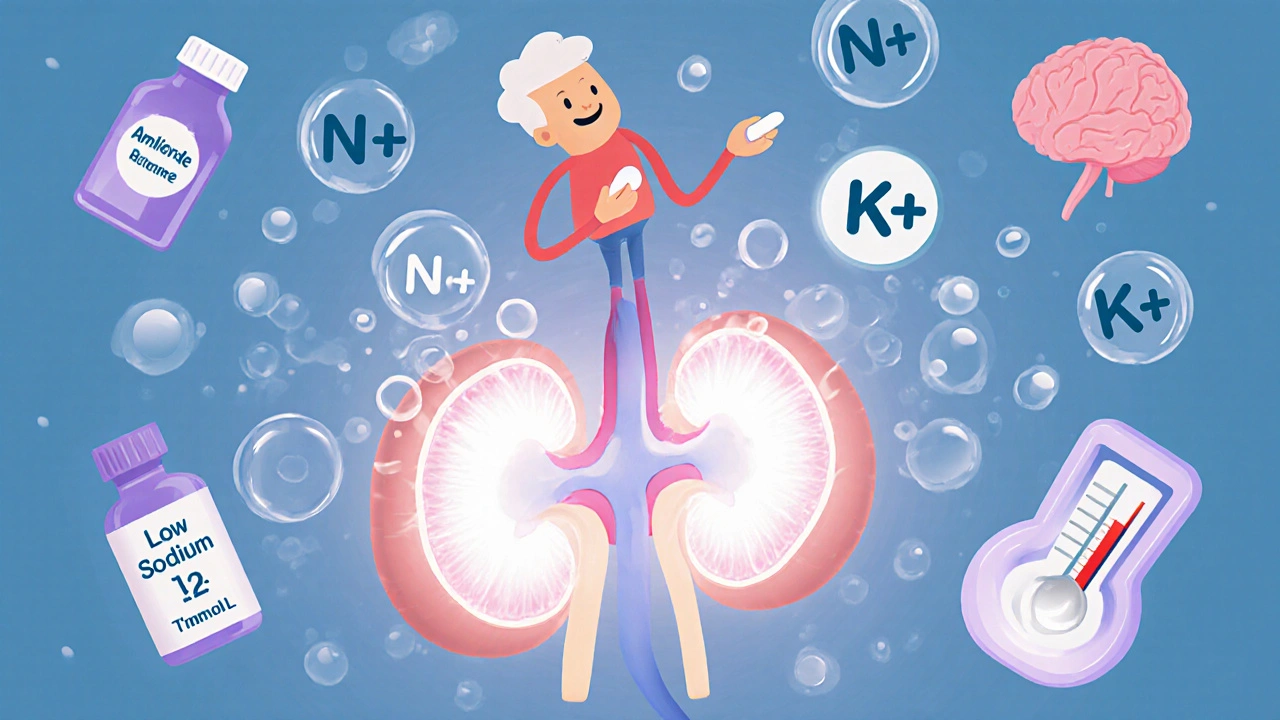When cancer patients lose balance in their electrolytes, it’s not just a lab result-it’s fatigue, confusion, muscle cramps, or even heart rhythm problems. One of the less talked about but highly effective tools in managing these imbalances is amiloride. Unlike common diuretics that flush out potassium, amiloride holds onto it while helping the body get rid of excess sodium and water. For cancer patients dealing with conditions like SIADH (syndrome of inappropriate antidiuretic hormone secretion) or chemotherapy-induced hyponatremia, this makes amiloride a quiet hero in the treatment room.
Why Electrolyte Imbalances Happen in Cancer Patients
Cancer doesn’t just grow in the body-it disrupts it. Chemotherapy, radiation, and the tumor itself can throw off sodium, potassium, magnesium, and calcium levels. One of the most common problems is low sodium, or hyponatremia. Up to 30% of cancer patients develop this, especially those with lung, brain, or pancreatic cancers. The cause? Often, tumors or treatments trigger the body to hold onto too much water, diluting the sodium in the blood.
Another issue is hypokalemia-low potassium. Many cancer drugs, like cisplatin, cause the kidneys to leak potassium. When that happens, patients get weak, nauseated, or develop dangerous heart rhythms. Treating it isn’t as simple as popping a potassium pill. If you give potassium without fixing the root cause, the body just pees it out again.
How Amiloride Works Differently
Most diuretics-like furosemide or hydrochlorothiazide-make you urinate more, but they also strip away potassium. That’s the opposite of what many cancer patients need. Amiloride works in a different part of the kidney: the collecting duct. It blocks sodium channels called ENaC (epithelial sodium channels), which stops sodium from being reabsorbed. When sodium stays in the urine, water follows it out, reducing fluid overload. But here’s the key: potassium doesn’t get dragged along. Amiloride actually helps keep potassium in the bloodstream.
This makes it perfect for two common cancer-related problems:
- SIADH: The body holds onto water because of excess ADH hormone. Amiloride helps flush out the extra water without losing potassium.
- Chemotherapy-induced hypokalemia: When drugs like cisplatin or ifosfamide cause potassium wasting, amiloride helps the kidneys hold onto what’s left.
It’s not a cure, but it’s a stabilizer. In clinical practice, it’s often used alongside fluid restriction or hypertonic saline in SIADH cases-not as a first-line drug, but as a targeted add-on when other treatments aren’t enough or cause side effects.
Real-World Use: When Doctors Choose Amiloride
Imagine a 62-year-old with small cell lung cancer. After two rounds of chemotherapy, they start feeling dizzy, confused, and nauseated. Blood tests show sodium at 124 mmol/L (normal is 135-145). They’re not vomiting or sweating-no obvious reason for low sodium. The diagnosis: SIADH.
First-line treatment? Fluid restriction. But if the patient is already drinking barely enough to stay hydrated, cutting fluid further isn’t safe. Tolvaptan, another option, can be expensive and risky for liver function. That’s where amiloride comes in. A typical dose is 5-10 mg daily. Within 48-72 hours, sodium levels begin to rise steadily. No need for IV saline. No risk of osmotic demyelination from too-fast correction.
Another case: a 58-year-old with ovarian cancer on cisplatin. Her potassium drops to 2.8 mmol/L after every cycle. Oral potassium supplements don’t stick-she’s urinating it out. Her oncologist adds amiloride 5 mg daily. Her potassium stays above 3.5. She keeps her strength, doesn’t need IV potassium, and finishes her treatment without interruption.
These aren’t rare stories. In oncology units across the UK and US, amiloride is quietly being used in about 12-15% of hyponatremic cancer patients, especially when other options fail or aren’t tolerated.

Side Effects and Risks
Amiloride isn’t risk-free. The biggest concern is hyperkalemia-too much potassium. This is rare at standard doses (5-10 mg/day), but it can happen if the patient has kidney problems, is on ACE inhibitors, or takes NSAIDs. Cancer patients often have reduced kidney function due to dehydration, tumor burden, or chemo toxicity. That’s why doctors check potassium levels within 3-5 days of starting amiloride, then weekly for the first month.
Other side effects are mild: dizziness, headache, or upset stomach. But because it’s not a strong diuretic, it doesn’t cause the dramatic drops in blood pressure or dehydration that loop diuretics can. That’s a big plus for frail, elderly cancer patients.
One thing to watch: amiloride can slightly raise creatinine levels. That doesn’t mean kidney damage-it just means the drug is working in the tubules. If creatinine jumps more than 30% from baseline, it’s time to recheck kidney function and consider dose adjustment.
How It Compares to Other Potassium-Sparing Diuretics
There are two main potassium-sparing diuretics: amiloride and spironolactone. Both keep potassium, but they work differently.
| Feature | Amiloride | Spironolactone |
|---|---|---|
| Primary Mechanism | Blocks sodium channels in collecting duct | Blocks aldosterone receptors |
| Best For | SIADH, chemo-induced potassium loss | Ascites, aldosterone excess, heart failure |
| Onset of Action | 2-3 days | 3-5 days |
| Common Side Effects | Dizziness, mild GI upset | Breast tenderness, gynecomastia, menstrual changes |
| Drug Interactions | ACE inhibitors, NSAIDs, potassium supplements | Same, plus higher risk of gynecomastia with long-term use |
| Dosing in Cancer Patients | 5-10 mg once daily | 25-100 mg once daily |
For cancer patients, amiloride often wins because it doesn’t mess with sex hormones. Spironolactone can cause breast enlargement or painful nipples in men-a big problem for someone already dealing with cancer’s emotional toll. Amiloride doesn’t do that. It’s simpler, cleaner, and more predictable.

When Not to Use Amiloride
There are clear red flags:
- Severe kidney disease (eGFR below 30 mL/min)
- Already high potassium (above 5.0 mmol/L)
- On multiple drugs that raise potassium (like ACE inhibitors, ARBs, or trimethoprim)
- Adrenal insufficiency (Addison’s disease)
Also, don’t use it alone for severe hyponatremia (sodium below 120 mmol/L). In those cases, you need rapid correction with hypertonic saline under close monitoring. Amiloride is for gradual, safe correction-not emergency fixes.
Monitoring and Practical Tips
If amiloride is started, here’s what to track:
- Baseline electrolytes (sodium, potassium, creatinine) before starting
- Repeat electrolytes at 48-72 hours
- Check again at 7 days, then weekly for the first month
- Watch for signs of hyperkalemia: muscle weakness, slow heartbeat, palpitations
- Ask about dizziness-especially when standing up
Patients should avoid salt substitutes (like potassium chloride), which can spike potassium levels. They should also avoid NSAIDs (ibuprofen, naproxen) because those reduce kidney blood flow and raise the risk of hyperkalemia.
Amiloride isn’t a magic bullet, but for the right patient, it’s a game-changer. It gives oncologists a tool to fix electrolyte problems without making others worse. It’s gentle, targeted, and doesn’t add more burden to an already overwhelmed body.
What Comes Next?
Research is still evolving. A 2024 study in the Journal of Clinical Oncology followed 142 cancer patients with SIADH. Those treated with amiloride had a 68% success rate in normalizing sodium within 10 days, with no cases of osmotic demyelination. That’s better than fluid restriction alone.
Future directions? Combining amiloride with low-dose urea to pull water out of the brain. Or using it with newer drugs like vaptans in patients who can’t tolerate them. But for now, amiloride remains a practical, affordable, and underused option.
If you’re managing a cancer patient with stubborn electrolyte issues, ask: Is this about too much water? Or too little potassium? Amiloride might be the quiet answer you’ve overlooked.
Can amiloride be used in all cancer patients with low sodium?
No. Amiloride is best for mild to moderate hyponatremia caused by SIADH or drug-induced water retention. It’s not used for severe hyponatremia (sodium below 120 mmol/L), where rapid correction with hypertonic saline is needed. It’s also avoided in patients with advanced kidney disease or already high potassium levels.
Does amiloride cause weight loss in cancer patients?
It can lead to a small amount of fluid loss, which might show up as a slight drop in weight. But it doesn’t cause muscle or fat loss. In patients with fluid retention from cancer or treatment, this can actually improve comfort and reduce swelling. It’s not a weight-loss drug.
How long does it take for amiloride to work?
It usually takes 2 to 3 days to start lowering sodium levels in SIADH, and up to 5 days to stabilize potassium. Unlike IV treatments, it works slowly and steadily-reducing the risk of dangerous corrections. Full effect is seen within a week.
Can amiloride be taken with chemotherapy?
Yes, and it often is. It’s commonly used alongside cisplatin, ifosfamide, and other drugs that cause potassium loss. Doctors monitor potassium levels closely, but amiloride helps prevent the need for frequent IV potassium infusions. Always check for interactions with other medications like ACE inhibitors or NSAIDs.
Is amiloride better than spironolactone for cancer patients?
For many cancer patients, yes. Amiloride doesn’t affect hormones, so it avoids side effects like breast tenderness or gynecomastia that spironolactone can cause. It also works faster. If the goal is correcting sodium or potassium without adding hormonal side effects, amiloride is often the preferred choice.
What should patients avoid while taking amiloride?
Avoid salt substitutes containing potassium, NSAIDs like ibuprofen, and ACE inhibitors unless closely monitored. Also, avoid excessive fluid intake if they have SIADH. Drinking too much water can undo the benefits of the drug. Stick to doctor-recommended fluid limits.
 Oct, 23 2025
Oct, 23 2025
